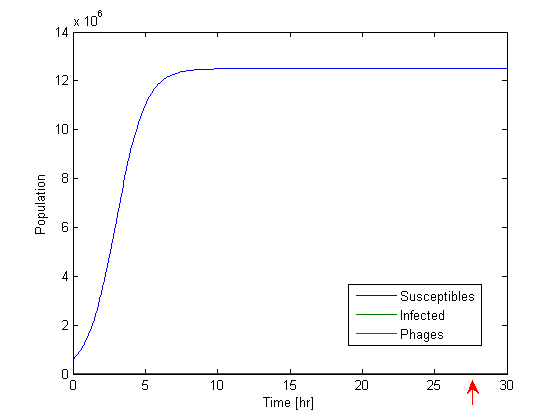Team:LCG-UNAM-Mexico:odes
From 2009.igem.org
 |
|---|
Deterministic population dynamics modelSome bacteriophages are parasites of bacteria, and as such, must prudently exploit their resources (in this case bacteria) to avoid killing bacterium before reproduce enough copies of itself. It has been suggested that parasites have evolved to tune their degree of virulence (amount of damage the parasite causes to the host) to achieve a balance between rapid reproduction and a prudent use of resources [1]. It is this fine balance which we intend to break, increasing the virulence of phage in such a way that kills the bacterium so fast that the phage is unable to assemble their own copies. As a first approach, the infection process was mathematically modeled with a system of differential equations. It is important to consider that the amount of phages at a given moment depends on the amount of phages on a previous point in time due to the latency period (once the phage has inserted its genome, it requires a period of time to redirect the molecular machinery of the bacteria, reproduce and start assembling). To tackle this problem, we modeled the phage infection using a system of [http://en.wikipedia.org/wiki/Delay_differential_equation DELAY DIFFERENTIAL EQUATIONS (DDE)] based on the system proposed by Beretta [2]. The use of DDE allows us to update the system depending on the states of the system in previous points in time.
Contents
Populations
Description of the system of nonlinear differential equations
Parameters
ResultsThe initial population was coded as a population vector [Susceptible Infected Phages] in Matlab. As there are no phages present, the infected and phage populations does not increase and E. coli grows normally. Susceptibles bacteria becomes infected when phages are added. Bacterial death is only caused by phage lysis product, therefore, the death rate is set to one time the inverse of the latency period (μi=5).
when T7 infects a bacterium which has the suicide circuit, μi (mortality rate caused by suicide system) is increased, host bacteria die before the phages reproduce itself. The mortality parameter estimated caused by the toxin is five times the inverse of the latency period (μi=25). |
Assumptions
In this modelling approach we assume that:
- One phage is only able to infect one bacterium.
- Bacteria and phages are well mixed (in equilibrium), neglecting the spatial considerations.
References
[1] Frank, S. A. 1996 Models of parasite virulence. Q. Rev. Biol. 71, 37–78.
[2] E. Beretta, Y. Kuang (2001): Modeling and Analysis of a Marine Bacteriophage Infection with Latency Period. Nonlinear Analysis : Real World Applications, 2, 35-74
[3] L.F. Shampine and S. Thompson, Solving DDEs in MATLAB.
[4] Heineman, R., Springman, R., Bull, J. (2008). Optimal Foraging by Bacteriophages through Host Avoidance. The American Naturalist, 171(4), E149-E157.
[5] De Paepe M, Taddei F (2006) Viruses' life history: Towards a mechanistic basis of a trade-off between survival and reproduction among phages. PLoS Biol 4(7): e193. DOI: 10.1371/journal.pbio.0040193.
|}
 |  |  |
|---|
 |
|---|
 "
"









